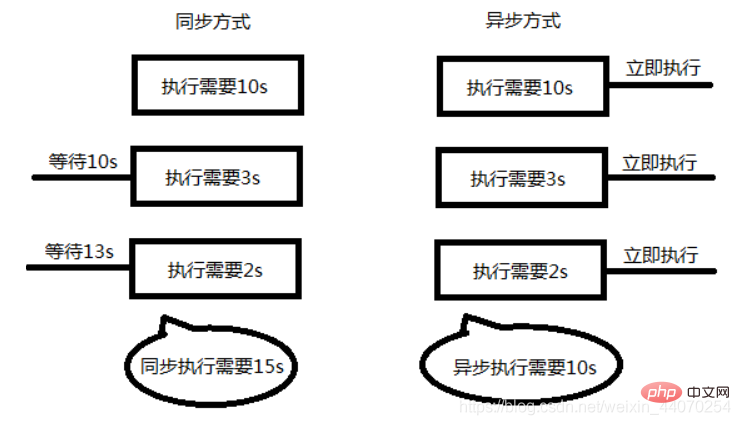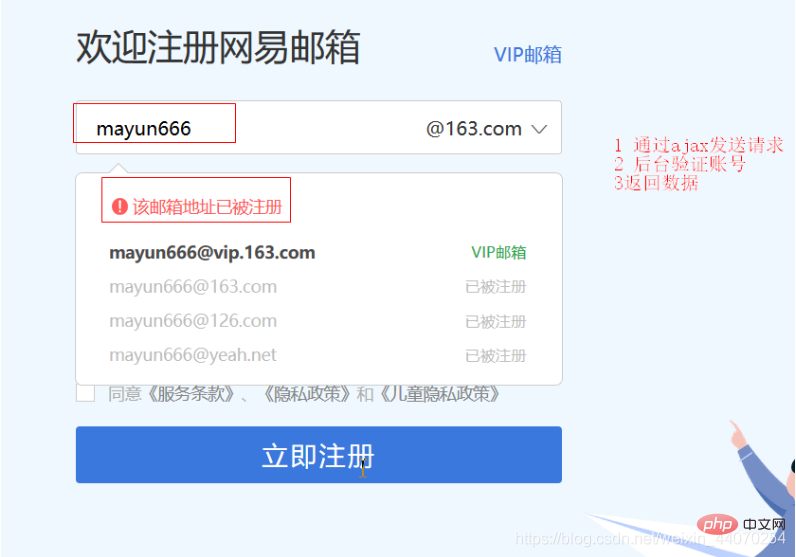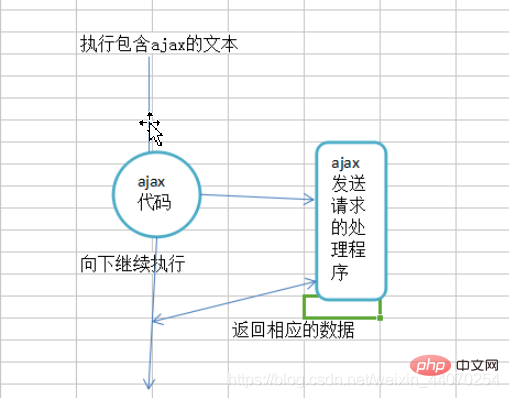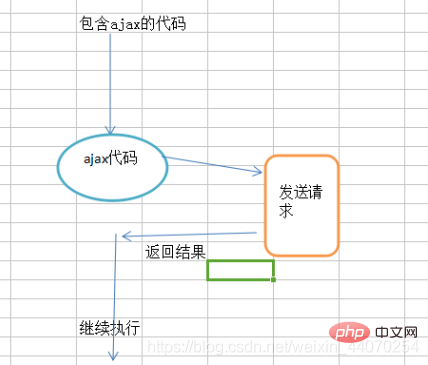Home >Web Front-end >Front-end Q&A >Let's briefly talk about how to use ajax to interact
Let's briefly talk about how to use ajax to interact
- WBOYWBOYWBOYWBOYWBOYWBOYWBOYWBOYWBOYWBOYWBOYWBOYWBforward
- 2022-02-08 17:52:542762browse
This article brings you relevant knowledge about ajax interaction, including synchronous and asynchronous, callback functions, the use of promises and other related issues. I hope it will be helpful to everyone.

Synchronous and asynchronous
Synchronous: It means that things must be done one by one. You can do the next task only after completing the previous one
Asynchronous: Not affected by the current task, two things are done at the same time. When doing one thing, it does not affect the progress of the other thing.
In programming: When asynchronous program code is executed, it will not block the execution of other program codes, thus improving the overall execution efficiency.

The concept of ajax
What is ajax
1 Ajax: asynchronous javascript and xml (asynchronous js and xml)
2 is one of the technologies that can interact (asynchronously/synchronously) with the server.
ajax的语言载体是javascript。 最大特点:页面不刷新 ajax的一些常见应用,使网页无刷新向web服务器发送请求数据.


The history of the emergence of ajax
In 1999, when Microsoft released the IE5 browser, it was embedded technology. The original name was XMLHttp
Until 2005, Google released an email product gmail, which used ajax technology internally. This incident attracted people's attention to ajax, and also caused the languishing javascript language to be taken seriously from now on
Usage of ajax
XMLHttpRequest object
The browser's built-in object is used to communicate with the server (exchange data), so that we can partially update the web page instead of refreshing it entire page. This request is asynchronous, that is, when sending the request to the server, it will not hinder the running of the program, and the browser will continue to render subsequent structures.
Ajax operation
Be sure to open phpsudy, and the js file and php file are on the same host before the request can be successful.
Creation of GET request
Creation and sending of request
Creation of mainstream browsers (Firefox, Google, Apple Safari, Opera, including IE8 and above) The method is also the main one used now.
//1. 创建一个XMLHttpRequest对象var xhr = new XMLHttpRequest();
//2. 设置请求的类型,以及地址
// 第一个参数:请求方式 get/post
// 第二个参数:请求的地址 需要在url后面拼上参数列表
// 第三个参数:默认是异步xhr.open("get", "01.php?name=Jepson",异步/同步);
//3.发送请求到服务器xhr.send(null);
Manual location
http://www.w3school.com.cn/ajax/ajax_xmlhttprequest_create.asp
USE OF GET
Example 1: Add a button to the page, click once to send a request to the php background, and php will write a piece of text into a.txt
<input>
<script>
function fn(){
// 1 实例化对象
let xhr = new XMLHttpRequest();
// 2 设置请求的类型以及地址
xhr.open('get','./02.php');
// 3 发送请求,get请求则设置为空,post请求则设置参数
xhr.send();
}
</script>
The php code is as follows
<?php $str = '越懒散,越懒!';$file = './a.txt';$f = fopen($file,'a'); fwrite($f,$str);?>
ajax status
By monitoring the request status, data can be accepted only when the status is equal to 4
xhrObj.onreadystatechange - Monitor the readyState status, and when the status changes, the corresponding function can be called for processing
The role of the five ajax states
/*xhrObj.readyState - Returns the status of the current request
When xhr.readyState = 0 - not initialized, the object has been established, and open() has not been called yet
xhr .readyState = 1 time - initialization, object creation did not call send()
xhr.readyState = 2 time - sending data, send() method call, but the current status and http header are unknown, the request is not completed
xhr .readyState = 3 o'clock - data transmission, accepting part of the data
xhr.readyState = 4 o'clock - response content parsing completed
*/
Example: Obtain the four states of the ajax request process
// 1 实例化对象
let xhr = new XMLHttpRequest();
xhr.onreadystatechange = function(){
// 4 使用回调函数检测当前的状态
console.log(xhr.readyState);
// 获取服务器状态码
console.log(xhr.status)
// 接受服务器返回数据
console.log(xhr.responseText);
}
// 2 创建请求
xhr.open('get','http://localhost/web/index.php');
// 3 发送请求
xhr.send();

Return server status code xhr.status
1**: Request received, continue processing
2**: Operation successfully received, analysis , Accept
3**: Completion of this request must require further processing
4**: The request contains an incorrect syntax or cannot be completed
5**: The server failed to execute a fully valid request
100——客户必须继续发出请求 101——客户要求服务器根据请求转换HTTP协议版本 200——客户端请求成功 201——提示知道新文件的URL 202——接受和处理、但处理未完成 203——返回信息不确定或不完整 204——请求收到,但返回信息为空 205——服务器完成了请求,用户代理必须复位当前已经浏览过的文件 206——服务器已经完成了部分用户的GET请求 300——请求的资源可在多处得到 301——删除请求数据 302——在其他地址发现了请求数据 303——建议客户访问其他URL或访问方式 304——客户端已经执行了GET,但文件未变化 305——请求的资源必须从服务器指定的地址得到 306——前一版本HTTP中使用的代码,现行版本中不再使用 307——申明请求的资源临时性删除 400——错误请求,如语法错误 401——请求授权失败 402——保留有效ChargeTo头响应 403——请求不允许 404——没有发现文件、查询或URl 405——用户在Request-Line字段定义的方法不允许 406——根据用户发送的Accept拖,请求资源不可访问 407——类似401,用户必须首先在代理服务器上得到授权 408——客户端没有在用户指定的饿时间内完成请求 409——对当前资源状态,请求不能完成 410——服务器上不再有此资源且无进一步的参考地址 411——服务器拒绝用户定义的Content-Length属性请求 412——一个或多个请求头字段在当前请求中错误 413——请求的资源大于服务器允许的大小 414——请求的资源URL长于服务器允许的长度 415——请求资源不支持请求项目格式 416——请求中包含Range请求头字段,在当前请求资源范围内没有range指示值,请求也不包含If-Range请求头字段 417——服务器不满足请求Expect头字段指定的期望值,如果是代理服务器,可能是下一级服务器不能满足请求 500——服务器产生内部错误 501——服务器不支持请求的函数 502——服务器暂时不可用,有时是为了防止发生系统过载 503——服务器过载或暂停维修 504——关口过载,服务器使用另一个关口或服务来响应用户,等待时间设定值较长 505——服务器不支持或拒绝支请求头中指定的HTTP版本
Server response value reception
To obtain the response from the server, use the responseText or responseXML attribute of the XMLHttpRequest object.
| Attributes | Description |
|---|---|
| Get the characters Response data in string form. | |
| Get response data in XML form (know). |
The above is the detailed content of Let's briefly talk about how to use ajax to interact. For more information, please follow other related articles on the PHP Chinese website!



